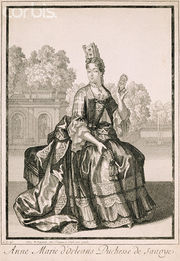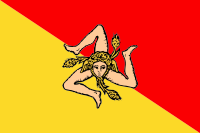Victor Amadeus II of Sardinia
| Victor Amadeus II | |
|---|---|
| King of Sardinia prev. King of Sicily |
|
 |
|
|
|
|
| Reign | 12 June 1675 – 3 September 1730 |
| Predecessor | Charles Emmanuel II |
| Successor | Charles Emmanuel III |
|
|
|
| Reign | 22 September 1713 – 17 February 1720 |
| Predecessor | Philip IV |
| Successor | Charles IV |
|
|
|
| Reign | 17 February 1720 – 3 September 1730 |
| Predecessor | Charles III |
| Successor | Charles Emmanuel III |
| Spouse | Anne Marie d'Orléans Anna Teresa Canalis di Cumiana |
| Issue | |
| Maria Adelaide, Dauphine of France Maria Luisa, Queen of Spain Maria Vittoria, Princess of Carignan (illegitimate) Victor Amadeus, Prince of Piedmont Charles Emmanuel III of Savoy Emanuele Philibert, Duke of Chablais |
|
| Father | Charles Emmanuel II, Duke of Savoy |
| Mother | Marie Jeanne of Savoy |
| Born | 14 May 1666 Turin, Italy |
| Died | 31 October 1732 (aged 66) Turin, Italy |
Victor Amadeus II, Italian Vittorio Amedeo II (14 May 1666 – 31 October 1732) was Duke of Savoy from 1675 to 1730. He also held the titles of marquis of Saluzzo, duke of Montferrat, prince of Piedmont, count of Aosta, Moriana and Nizza.
His mother Marie Jeanne of Savoy was the regent from 1675 to 1680 but maintained power till 1684. He first became king of Sicily (1713-1718), but he was forced to exchange this title and instead became king of Sardinia (1720-1730).
Contents |
Biography
Victor Amadeus was born in Turin to Charles Emmanuel II, Duke of Savoy and his second wife Marie Jeanne of Savoy. He was their only child. At his father's death on 12 June 1675 he became the Duke of Savoy with a regency placed under the power of his dominating mother. His mother tried to gain the throne of Portugal for her son by engaging him to his cousin Isabel Luísa, Princess of Beira, only child and presumptive heiress of her father, Peter II of Portugal. This would have left Marie Jeanne Baptiste permanently in full control of the Duchy of Savoy as Regent because her son would have had to live in Portugal with his new wife.
But the birth of a son for King Peter II of Portugal and a revolt in Piedmont supported by Victor Amadeus forced Marie Jeanne Baptiste to abandon her plans and hand over power to her son on 14 March, 1684. Other candidates Candidates for marriage included Maria Antonia of Austria (daughter of Emperor Leopold I) and Countess Palatine Maria Sofia of Neuburg bit nothing came of the matches. Anna Maria Luisa de' Medici was also considered.
Marie Jeanne would retain great influence over her first grandchild Maria Adelaide, future Dauphine of France.
He married Anne Marie d'Orléans. She was the youngest child of Philippe de France (brother of Louis XIV) and Henrietta Anne of England (daughter of the murdered Charles I of England). The contract of marriage between Anne Marie and the Duke of Savoy was signed at Versailles on 9 April; On 10 April, 1684, Anne Marie was married at Versailles, by proxy, to Víctor Amadeus.[1]. Victor Amadeus was represented by the duc du Maine, son of Louis XIV and Madame de Montespan.
Anne Marie, a devoted wife ignored his affairs and accepted his illegitimate children. Victor Amadeus had issue with his favourite mistress Jeanne Baptiste d'Albert de Luynes including the future Princess of Carignan who was the paternal grandmother of Princess Marie Louise of Savoy, princesse de Lamballe. He married Anna Teresa Canalis di Cumiana (1679-1769) in a morganatic union after the death of Anne Marie.
Internal reforms
Victor Amadeus II undertook sweeping administrative reforms within Savoy-Piedmont. In 1696 he established a system of intendents, based on the French model, responsible for collecting taxes and law enforcement. In 1697 he began a land survey which was largely completed by 1711, the Perequazione, to examine the land holdings and privileges of the Church and nobility. In 1717 he reformed the secretariat system in Turin establishing individual secretaries for war, internal affairs and foreign affairs. From the 1670s he also had a new administrative zone built in Turin, around the ducal palace. This zone included a military academy, the ministry of war, a mint, and a customs house. This work was still ongoing upon his death.
Victor Amadeus also undertook a number of military reforms. In 1690 he established a select militia within his territories, he later overhauled the militia system in 1714 and strictly codified it. From 1713 he also began to establish his own navy based on the limited Sicilian naval forces he had been granted.
Foreign policy
Under his mother's regency Savoy, despite being a state of the Holy Roman Empire, was closely linked to and heavily dependent upon France, essentially becoming a French satellite. Victor Amadeus II broke this link with France by joining alliances against Savoy's neighbour in both the Nine Years War and the War of the Spanish Succession.
Savoy was considered a valuable ally in both wars due to its geographical position, enabling a second front to be opened against France in the south. Savoy relied heavily on foreign subsidies, particularly from England and the Dutch Republic, in both wars to maintain its armies.
During the War of the Spanish Succession, foreign subsidies amounted for almost half of the revenue raised by Savoy to fight the war. In the War of the Spanish Succession, Savoy fared particularly badly against the larger French forces resulting in a siege of Turin in 1706, Anne Marie's uncle, Louis XIV of France (along with Spanish forces from Anne Marie's second cousin Philip V of Spain) besieged Turin during the Battle of Turin. French troops were under the control of Anne Marie's half brother, the Duke of Orléans. She and her sons, Victor Amadeus and Carlo Emanuele, were forced to flee Turin. They were only saved by the intervention of an army of the Holy Roman Empire under Prince Eugene of Savoy.
As a result of his aid in the War of the Spanish Succession, Victor Amadeus II was made King of Sicily in 1713 under the Treaty of Utrecht which ended the war. Victor Amadeus was forced to exchange Sicily for the less important kingdom of Sardinia in 1720 after objections from an alliance of four nations, including several of his former allies. Yet he retained his new title of King. The rule was that there were no kings within the Empire, but if a ruler subject to the Emperor also possessed a large territory outside the Empire he might claim this title as the Elector of Brandenburg had done, styling himself King in Prussia based on his sovereignty over the Duchy of Prussia.
The Vaudois
Victor Amadeus II began a large scale persecution of the Vaudois (Piedmontese and Savoyard Protestants) in 1685. Due to his alliances with England and the Dutch Republic during the Nine Years War, he was forced to cease this practice from 1688, and in 1694 granted an Edict of Toleration.

Issue
Children of Victor Amadeus II by:
1. Anne Marie d'Orléans, Princess of France (27 August, 1669 – 26 August, 1728), daughter of Philippe de France (Philippe of France), Duke of Orléans and his first wife Henrietta of England.
Legitimate issue
- Princess Maria Adelaide of Savoy (1685-1712); married Louis, Duke of Burgundy and was the mother of Louis XV of France;
- Princess Maria Ana of Savoy (1687-1690);
- Princess Maria Luisa Gabriella of Savoy (1688-1714); first wife of Philip V of Spain;
- Princess X of Savoy (stillborn child, 1691);
- X of Savoy (stillborn child, 1697);
- Prince Victor Amadeus John Philip of Savoy (1699-1715), Prince of Piedmont;
- Prince Carlo Emanuele of Savoy (1701-1773); the next Duke of Savoy and King of Sardinia.
- Prince Emanuele Philibert of Savoy (1705-1705) Duke of Chablais.
Illegitimate issue
By Jeanne Baptiste d'Albert de Luynes, his mistress (1670-1736):
- Maria Vittoria Francesca of Savoy (9 February, 1690-8 July, 1766) married Victor Amadeus, Prince of Carignan and had issue; Vittoria's granddaughter was the princesse de Lamballe.
- Vittorio Francesco of Savoy (10 December, 1694 - 20 March, 1762) married Maria Lucrezia Franchi di Pont but had no issue;
By unknown mistress;
Donna Caterina di Savoia, (b. 1713 – † 1779), married Conte Giorgio Magro.
Ancestry
Titles, styles, honours and arms
Titles and styles
- 14 May 1666 – 12 June 1675 His Highness the Prince of Piedmont
- 12 June 1675 – June 1689 His Highness the Duke of Savoy
- June 1689 – 22 September 1713 His Royal Highness the Duke of Savoy
- 22 September 1713 – 24 August 1720 His Majesty the King of Sicily
- 24 August 1720 – 3 September 1730 His Majesty the King of Sardinia
- 3 September 1730 – 31 October 1732 His Majesty King Victor
References and notes
- ↑ Barker, Nancy Nichols, Brother to the Sun king: Philippe, Duke of Orléans, Johns Hopkins University Press, 1989.
External links
- Works by or about Victor Amadeus II of Sardinia in libraries (WorldCat catalog)
|
Victor Amadeus II of Sardinia
Born: 14 May 1666 Died: 31 October 1732 |
||
| Regnal titles | ||
|---|---|---|
| Preceded by Charles Emmanuel II |
Duke of Savoy 1675 – 1730 |
Succeeded by Charles Emmanuel III |
| Preceded by Emperor Charles VI |
King of Sardinia 1720 – 1730 |
|
| Preceded by Philip IV |
King of Sicily 1713 – 1720 |
Succeeded by Charles IV |
See also
|
||||||||||||||||
|
||||||||
|
|||||||
|
|||||||
